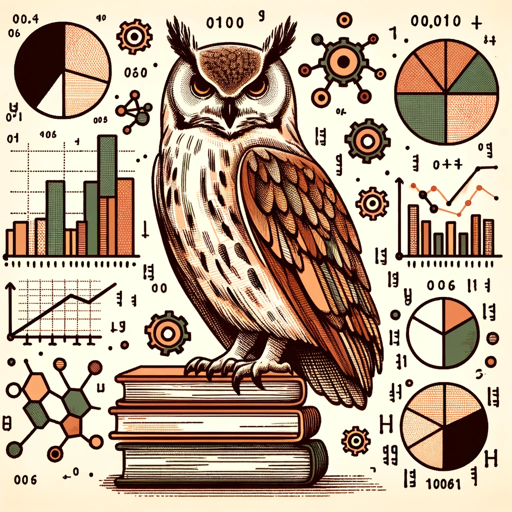Data Science Guru 🧠-AI-powered data analysis and modeling.
AI-powered tool for data science insights.
📊 How do I interpret this data set?
🤖 What's the best machine learning model for this?
👁🔍 Explain statistical significance to me.
📈 Can you help with data visualization?
Related Tools
Load More
Data Science
Expert in data analysis and visualization.

Data Science Consultant
Expert data science consultant and tutor, guiding on models, techniques, and code.

Data Science Owl
Select a demo dataset or upload a new one

IntellGPT - OSINT & Data Science
Gain Intelligence from any source - just give me website link, photo or text. Skilled in Intelligence Analysis, Data Science, and OSINT expertise.

Data Science Interview
Interviewer or interviewee in data science.

Tech Insight Guru
Expert in AI, ML, Deep Learning, LLM, Natural Language Processing (NLP), Transformers, Quantum Technology, Cybersecurity, Cyberintelligence, Digital Forensic, Governance, Information Security, Risk Management & Compliance.
20.0 / 5 (200 votes)
Introduction to Data Science Guru 🧠
Data Science Guru 🧠 is a specialized AI designed to assist users in data analysis, machine learning model creation, and business intelligence insights. It functions as a multi-purpose data science assistant, capable of performing tasks such as data interpretation, predictive modeling, and business performance monitoring. The tool caters to both beginner and advanced users, providing tailored insights based on their skill levels. Whether you're analyzing marketing campaigns, developing customer segmentation models, or predicting sales trends, Data Science Guru 🧠 offers comprehensive support. For example, a marketing team could use it to analyze customer engagement metrics and generate predictive models for future campaigns, while an advanced data scientist might use it to fine-tune machine learning algorithms to optimize operational performance.

Main Functions of Data Science Guru 🧠
Data Analysis and Interpretation
Example
Analyzing customer churn data to determine the most significant factors contributing to customer attrition.
Scenario
A telecommunications company wants to reduce customer churn. Using Data Science Guru 🧠, they can analyze historical customer data, identify patterns, and interpret key drivers such as pricing, customer service satisfaction, or contract length. The insights can then inform strategies to reduce churn, such as offering targeted promotions to at-risk customers.
Predictive Modeling and Forecasting
Example
Building a time-series forecasting model to predict future sales for an e-commerce company.
Scenario
An e-commerce business aims to optimize inventory management by accurately forecasting sales. Data Science Guru 🧠 can help by building a time-series model based on historical sales data, seasonal trends, and external factors such as marketing spend or holidays. The business can then make informed decisions about stocking and promotions, ensuring they don't run out of high-demand products.
Machine Learning for Business Monitoring
Example
Creating a machine learning model to detect anomalies in business transactions.
Scenario
A financial services company needs to identify potential fraudulent transactions. Data Science Guru 🧠 can be used to build a machine learning model that flags unusual transaction patterns in real-time. This proactive approach helps the company reduce fraud losses and comply with regulatory requirements, ensuring operational security.
Ideal Users of Data Science Guru 🧠
Business Analysts and Marketing Teams
These users benefit from Data Science Guru 🧠 by gaining deeper insights into campaign performance, customer behavior, and market trends. The tool helps them identify key performance indicators (KPIs), optimize marketing strategies, and use predictive models to anticipate future outcomes, such as customer retention or sales growth.
Data Scientists and Machine Learning Engineers
Advanced users such as data scientists and machine learning engineers can use Data Science Guru 🧠 to build, fine-tune, and deploy machine learning models. The tool enables them to experiment with algorithms, evaluate model performance, and integrate solutions into business operations. They benefit from automation, improved model accuracy, and a streamlined workflow for developing data-driven solutions.

How to Use Data Science Guru 🧠
Step 1
Visit aichatonline.org for a free trial without login, also no need for ChatGPT Plus.
Step 2
Ensure that you have a basic understanding of data science concepts such as statistics, machine learning, and Python programming for an optimal experience.
Step 3
Choose your data science task: data analysis, machine learning model creation, performance monitoring, or insights extraction. This tool can handle a wide range of tasks with specialized output.
Step 4
Input your query or data set. You can ask for help with specific data science tasks like regression models, attribution modeling, campaign analysis, or even generating insights from raw data.
Step 5
Review the generated results and recommendations. You can iterate based on feedback, refine your data models, or ask for further clarification on specific aspects of your task.
Try other advanced and practical GPTs
Image to Prompt
AI-powered prompts from your images

Wilbur - The Business Process Wizard 🧙♂️
AI-Powered Process Optimization Wizard

Кавычка GPT
AI-Powered Tool for Security Testing

Song Writer (Lyrics Gpt)
AI-driven lyric creation for musicians

Webbrowser
AI-powered real-time information assistant

EN-TR:SözcükUstası
AI-powered English-Turkish language assistant.

sci写作润色
Enhance your biomedical texts with AI

School
AI-powered learning for students and teachers.

PDF Wizard: Split, Merge, Edit
AI-powered PDF editor for easy file management.

Everything’s Stories
Turn Images into Stories with AI

Assistant
AI-powered assistance for every task.

马云模拟器
Simulate Wealth, Spend Wisely, Experience Luxury.

- Data Analysis
- Forecasting
- Performance Monitoring
- Model Creation
- Insights Extraction
Q&A About Data Science Guru 🧠
What kind of data science tasks can Data Science Guru 🧠 assist with?
Data Science Guru 🧠 excels at tasks such as analyzing data, creating predictive models, forecasting trends, and generating insights from complex datasets. It also helps with campaign performance analysis, attribution modeling, and business performance monitoring.
Do I need to know programming to use Data Science Guru 🧠?
While basic knowledge of data science concepts and Python programming will enhance your experience, Data Science Guru 🧠 simplifies complex tasks, making it accessible even to users without deep programming expertise.
What are the common use cases for Data Science Guru 🧠?
Common use cases include predictive modeling for forecasting, marketing campaign analysis, customer segmentation, business performance monitoring, and academic research. It can also be used for automating repetitive data tasks and exploring large datasets.
Can Data Science Guru 🧠 help with building machine learning models?
Yes, Data Science Guru 🧠 can assist with building machine learning models, from data preprocessing and feature selection to model evaluation and tuning. It can handle a variety of algorithms such as regression, classification, and clustering.
Is there a limit to the size of the datasets that Data Science Guru 🧠 can handle?
Data Science Guru 🧠 is optimized for efficiency, but the size of the dataset may impact performance. For very large datasets, it’s recommended to use efficient data processing techniques, and the tool can provide guidance on best practices for working with big data.